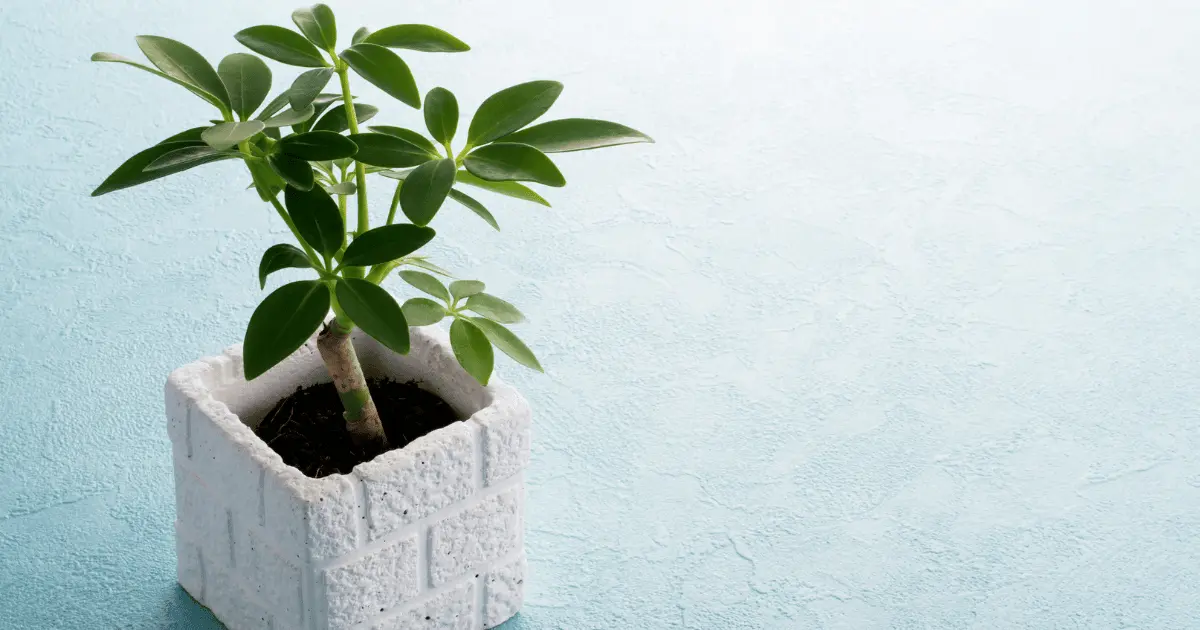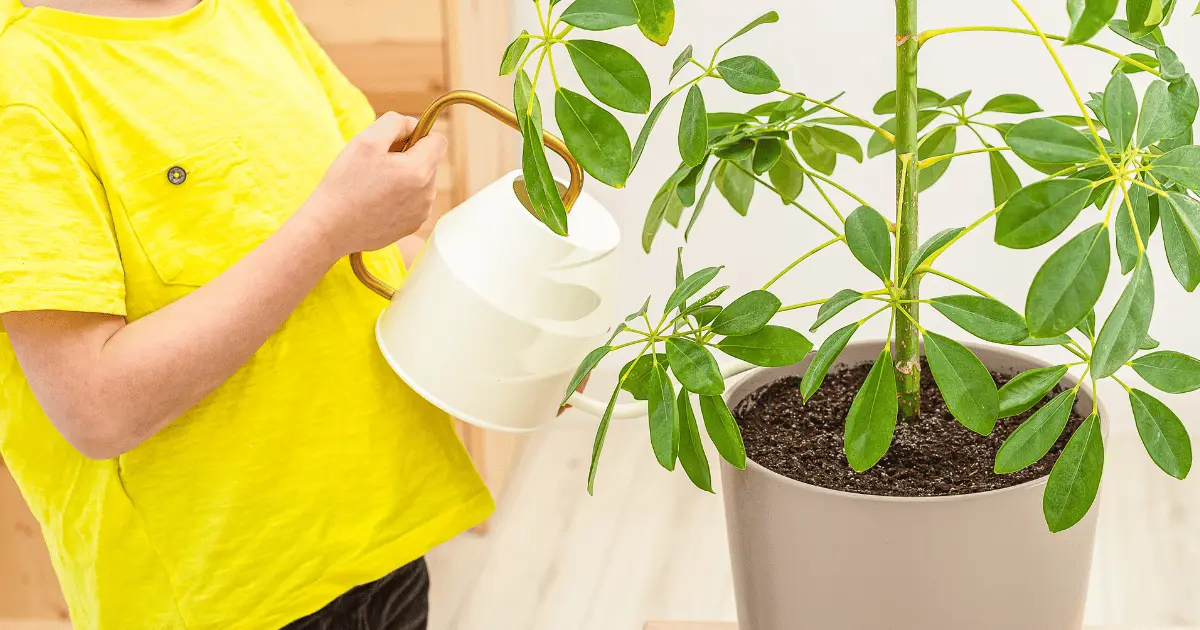Every consistent gardener eventually comes across one popular Schefflera variety sooner than later, and that’s for a good reason: growing Schefflera pots indoors quickly adds a touch of elegance, gentility, and natural tranquillity to the scene.
The two most commonly propagated Schefflera varieties include the Schefflera arboricola, also known as Dwarf Schefflera, with soft shiny compact variegated foliage, and Schefflera actinophylla, the regular sized Umbrella Plant that has extended shiny elliptical leaves. These are the only observable differences in both varieties, but they share many other similarities.
Propagating Schefflera Plants

It’s best to begin propagation immediately after Winter, just as the plant seems to be coming alive again after the long cold winter nights. They can also be grown in early fall when the atmosphere isn’t as hot and sunny as in summer.
It’s best to propagate them by stem cuttings, usually those of their leggy stems and offshoots. Schefflera easily grows leggy when they’re not pruned or propagated frequently; that’s why I always grow new pots immediately after I notice 2-3 leggy shoots on a grown plant.
Propagating them regularly keeps them looking young, fresh, and rejuvenating, glowing and blooming radiantly as desired.
Growing Schefflera Cuttings
You’ll only need a pair of gardening scissors or cutting implements to make the cuttings. Gently cut off the healthy leggy shoots that have grown several leaves on them. You can have as many cuttings as possible from a single plant, but ensure each cutting is at least 6 inches long.
Rooting hormones are beneficial to the cuttings, so dip the cut edge of the cuttings into the hormone after they must have healed; create tiny holes on the surface of your pots after pouring in some soil mix, then insert the cuttings into the holes to a maximum depth of 1-inch. At this stage, you should cover up the planted cuttings with more soil mix at the sides for better grip in the pot.
You may gently mist the pot immediately to make it humid enough for new growth. Now, place a transparent plastic bag over the pot to retain its humidity. They’ll begin to root after 2-3 weeks with the right watering and sunshine conditions and you can take away the plastic bag right afterwards to allow them to receive bright indirect sunshine after they’ve started rooting.
Growing your Young Scheffleras in the Right Conditions
Schefflera is generally classified between zones 10-12 of the USDA Hardiness Zones (somewhere between being hardy and woody or soft and herbaceous). They always like to be propagated where there’s adequate brightly shining indirect sunlight for about 7 hours daily.
Although they’ll easily grow in an averagely lighted indoor situation, they may only bloom if you take them outside occasionally to breathe in the summer sunshine. Seeing them bloom is amazing, and I always look forward to watching how they fully display their long white, pink, or red limb-like blooms.
They’re generally grown indoors where there’s plenty of indirect sunshine. Still, during their blooming spring and summer seasons, they must be brought outdoors for about 8 hours daily before you’ll see them getting set to bloom their lovely pigmented flowers. However, they should always be potted in shaded areas.
Schefflera will begin to look leggy and lose their charm when kept away from bright light for too long, and allowing them under direct sunlight for long could also give their leaves sunburns; it’s best to find the balance and maintain it for optimum results.
Choosing the Right Potting Mix for Schefflera
The quality of the soil mix used to propagate them will impact, in no small ways, their overall growth success, so it’s important to get prepared ahead with a lightweight potting mix that’s loose, gritty, fast-draining, and well-enriched with organic matter. A fast-draining Sandy-loam potting blend in outdoor environments will be a great choice.
Ensure that the Soil mix blend doesn’t hold water for too long; otherwise, the plant’s roots might start to rot. You’ll also want to check in with the Soil pH levels and ensure it’s mildly acidic; anything between 6.5-5.5 will be great. I always introduce a handful of perlite and organic compost into my homemade potting blend to improve its aeration and drainage.
Watering the Young Schefflera Plants

Schefflera are well suited for frequent watering, so ensure their leaves are always moist by spraying or misting them regularly. Please have a great watering plan where you ensure you only water them after their potting soil looks dry and powdery.
They won’t need regular watering in Winter due to their much-pronounced inactivity this season so It would be best if you only watered them once in 2-3 weeks.
It’s easy to kill the Scheffleras with over-watering, especially during Winter if their leaves are continuously damp and soggy. Over-watered pots will soon begin to drop their yellowing bloated, weak leaves, and eventually, the bloated stems will break off too.
Schefflera Toxication Levels
Schefflera are fatally toxic to humans and animal pets, especially crawling infants, dogs, and cats, and ingesting their untreated or unprocessed extracts can lead to severe health consequences, including kidney failures.
Other poisoning symptoms caused by direct contact with their raw parts include heart and respiratory issues, kidney troubles, nausea, vomiting, etc.
Propagating Schefflera varieties can be a wonderful gardening experience because they’re easily grown as indoor potting and as widely in-demand low-maintenance garden plants. Providing the right growing environment keeps them shooting up at a fast-growing rate, adding almost three feet to their heights annually till they reach the peak of 4-20 meters (160-800 inches) at full maturity.
Schefflera has a typical lifespan of more than three decades, so you can consider them a lifetime beauty-adding companion as long as they’re receiving all the right conditions to sustain their appealing forms. They have a broad genus of over 600 varieties of evergreen shrubs, hardy trees, and vining lianas, so you’ll most likely find one that meets your peculiar expectations.
Let’s conclude by discussing some of their amazing benefits in a minute. Schefflera has several medicinal and cosmetic benefits, and their essences and extracts are useful in treating various inflammations, cancers, allergies, malaria, and other parasitic infections. They can be described as having anti-angiogenic, immunomodulatory, chemopreventive, and cytostatic properties.
